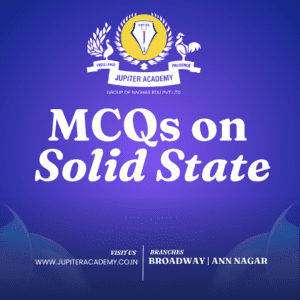Advisory and Instructions on Updation of Aadhaar Card/ UDID Card/...
Read More
MCQs on Solid State
Here are some important NEET Chemistry MCQs with answers:
1. Which of the following is not a chemical change?
(A) Burning of wood (B) Curdling of milk (C) Rusting of iron (D) Melting of ice
Answer: (D)
Melting of ice is a physical change, not a chemical change. In a physical change, the chemical composition of the substance does not change. In melting of ice, the ice changes from solid to liquid state, but the chemical composition of water remains the same.
2. Which of the following is a physical property?
(A) Density (B) Boiling point (C) Solubility (D) Conductivity
Answer: (A)
Density is a physical property, not a chemical property. Physical properties are properties that can be observed or measured without changing the chemical composition of the substance. Density is the mass of a substance per unit volume. Boiling point, solubility, and conductivity are chemical properties.
3. Which of the following is a chemical property?
(A) Luster (B) Hardness (C) Reactivity (D) Color
Answer: (C)
Reactivity is a chemical property, not a physical property. Chemical properties are properties that describe how a substance will react with other substances. Luster, hardness, and color are physical properties.
4. Which of the following is a pure substance?
(A) Air (B) Water (C) Salt water (D) Soil
Answer: (B)
Water is a pure substance. A pure substance is a substance that has a definite composition and cannot be separated into other substances by physical means. Air, salt water, and soil are all mixtures. A mixture is a substance that has a variable composition and can be separated into other substances by physical means.
5. Which of the following is a heterogeneous mixture?
(A) Salt water (B) Air (C) Soil (D) Sugar solution
Answer: (C)
Soil is a heterogeneous mixture. A heterogeneous mixture is a mixture that has a non-uniform composition. The different components of a heterogeneous mixture can be easily distinguished from each other. Salt water, air, and sugar solution are all homogeneous mixtures. A homogeneous mixture is a mixture that has a uniform composition. The different components of a homogeneous mixture cannot be easily distinguished from each other.
6. Which of the following statements is true about a crystalline solid?
a) It has a definite shape and volume.
b) Its constituent particles are arranged randomly.
c) It lacks long-range order.
d) It is always amorphous.
Answer: c) It lacks long-range order.
7. The coordination number of a particle in a simple cubic lattice is:
a) 6
b) 8
c) 4
d) 12
Answer: c) 4
8. Which of the following is an example of a molecular solid?
a) Sodium chloride (NaCl)
b) Copper (Cu)
c) Dry ice (CO2)
d) Iron (Fe)
Answer: c) Dry ice (CO2)
9. Which of the following substances has a body-centered cubic (bcc) structure?
a) Sodium chloride (NaCl)
b) Aluminum (Al)
c) Carbon (C)
d) Silver (Ag)
Answer: b) Aluminum (Al)
10. The fraction of empty space in a body-centered cubic (bcc) unit cell is:
a) 26%
b) 32%
c) 48%
d) 68%
Answer: b) 32%
11. Which of the following defects in a crystal lattice increases the density of the material?
a) Frenkel defect
b) Schottky defect
c) Substitutional defect
d) Interstitial defect
Answer: c) Substitutional defect
12. The density of a substance with a face-centered cubic (fcc) structure is:
a) (2 × atomic mass) / (edge length)^3
b) (4 × atomic mass) / (edge length)^3
c) (4 × atomic mass) / (2 × edge length)^3
d) (2 × atomic mass) / (2 × edge length)^3
Answer: b) (4 × atomic mass) / (edge length)^3
13. The electrical conductivity of a substance increases with an increase in:
a) Bandgap
b) Temperature
c) Impurities
d) Crystal defects
Answer: d) Crystal defects
14. The phenomenon of breaking a crystal into smaller pieces with the same crystal structure is called:
a) Cleavage
b) Lattice energy
c) Crystal lattice
d) Polymorphism
Answer: a) Cleavage
15. Which of the following is an example of an amorphous solid?
a) Quartz (SiO2)
b) Diamond (C)
c) Glass
d) Sodium chloride (NaCl)
Answer: c) Glass
Here are some NEET – JEE MCQs (Multiple Choice Questions) on the topic of Solid State, along with their answers:
Please note that these questions and answers are for illustrative purposes only and may not cover all aspects of the topic. It is always recommended to refer to the specific syllabus and study materials provided by your NEET preparation course or institution for comprehensive and accurate information.
These are just a few of the many important NEET Chemistry MCQs. By practicing these questions, you can improve your chances of success on the NEET exam.
Chapter Wise Weightage for NEET 2024 – Click Here
NEET 2025: OMR Sheet Filling Tips to Avoid Mistakes
NEET 2025: OMR Sheet Filling Tips to Avoid Mistakes Preparing...
Read MoreTN Medical 2024 Counseling: Extension of Round 2 for MBBS & BDS
TN Medical 2024 Counseling: Extension of Round 2 for MBBS...
Read MoreMCQs on Solid State
MCQs on Solid State MCQs on Solid State MCQs on Solid State MCQs on Solid State MCQs on Solid State
MCQs on Solid State
MCQs on Solid State
MCQs on Solid State
MCQs on Solid State
MCQs on Solid State





